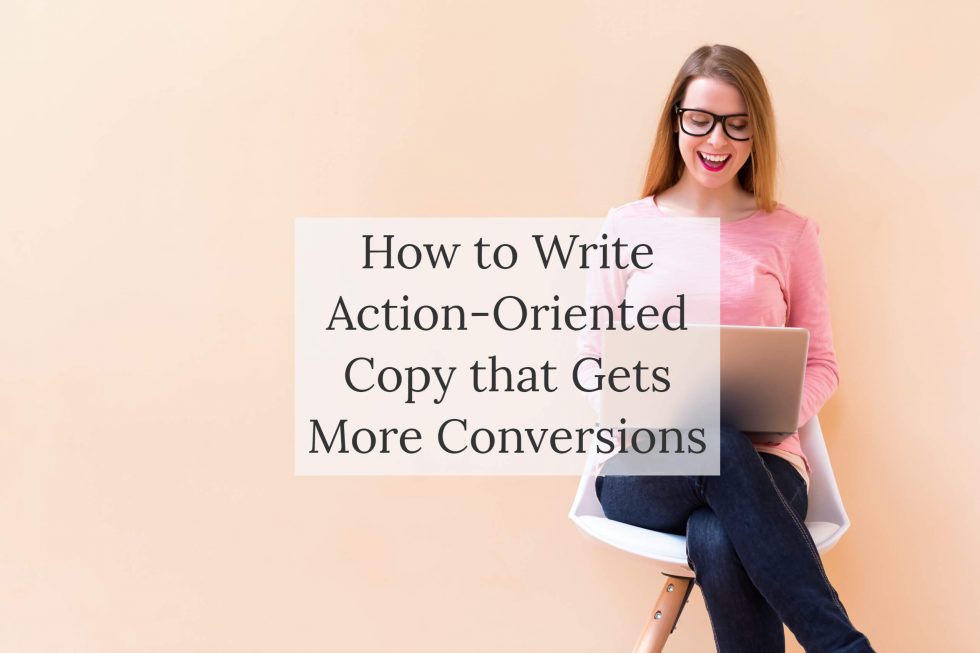
7 Tips for Writing Action-Oriented Copy
You may have heard of action-oriented copy, but do you know what it is and how you can leverage it for your business?
Simply put, action-oriented copy refers to the words on your website that motivates potential clients to take a desired action. Rather than just informing, this type of writing drives action.
In other words, action-oriented copy can help you get more conversions.
In this article I’ve tried to demystify the process of writing action-oriented copy by breaking it down into 7 key ideas. Follow these steps and you’ll be well on your way to writing powerful, effective action-oriented copy like a pro.
1. Determine the action you want your reader to take
This may seem obvious, but starting with a plan is always a good idea. Knowing what you ultimately want readers to do will make your copywriting process go much more smoothly. To define your outcome, think about the purpose of your copy in a way that focuses on doing. Do you want your reader to join your mailing list, like your social media post, contact you for a quote, or purchase your product?
2. Start with a verb
Did you know that tweets that begin start with verbs get the most shares on Twitter? People generally focus on the first few words in a sentence when they are reading online.
This means the first words are what count. By starting with a verb, you immediately prompt your reader to take action. Instead of writing “We’ve launched a new product,” write a much more powerful action-based phrase like “Check out our new product now” or “Learn what’s new” or “Take a sneak peak today”.
Still not convinced? Check this out this advice from HubSpot:
By not including a verb in the CTA [call to action] copy, you aren’t prompting readers to take action, which can hurt the click-through rate of your call-to-action and negatively impact conversions.
3. Include a clear call-to-action (CTA)
A critical component of action-oriented copy is your “call-to-action”, or CTA. This is where you tell your readers exactly what you want them to do in a way that you hope will motivate them to take action.
Your CTA should be clear, concise, and written in language that appeals to your audience. It could be in the form of a hyperlink (“Click here for a free download”) or a button (“Add to cart”) that takes your reader to the next page where they can complete the action.
Some common CTAs include: Register for a free trial; Sign-up today for our newsletter; Try it out for free today; Like us for your chance to win; Visit us at our store; Contact us for a no-obligation quote.
4. Guide your visitors and reinforce your message
In addition to your CTA being impactful, you should craft the rest of your webpage to guide your reader towards the action you want them to take.
This (usually) means having one or two CTAs per page and reinforcing your message by mentioning your CTA several times on the page. Put succinctly by Successful Blogging: “The key is to not leave people hanging – give them clear direction on what to do next within or at the end of each page or post.”
5. Always emphasize benefits
When it comes to choosing the actual words to include in your copy that surrounds your CTA, steer away from simply listing what services you offer and focus on what benefits and advantages your clients will get over other companies. Assume that your reader understands what their problem is and is visiting your website to make a decision between you and your competitor.
Also, be sure to remove any buyer hesitation by addressing potential concerns head on and explaining why you are a good choice. This will make your copy more effective and your CTA backed by solid reasoning.
6. Keep your copy concise
Did you know that people read differently on a computer screen than on paper? Computer screens make reading more difficult so people tend to fixate their eyes on the top left corner and scan down the page from there.
If you keep your copy short, concise, tight and with lots of white space around it, people will be more likely to read to the bottom. Also, keep your CTA short for maximum impact.
7. Put your CTA in the right place
If your CTA comes too early, your audience won’t be ready for it. If it comes too late, you may miss potential clients who stop reading after the first page. Therefore, placement of your CTA is critical.
Getting it right means placing it where your audience is mostly likely to see it and backing it up with evidence for why they should take action. Including your CTA more than once offers readers multiple moments at which they can take action.
In Summary…
It’s that simple.
Follow these 7 points and you’ll be well on your way to writing powerful, action-oriented copy that gets more conversions.




Add A Comment
You must be logged in to post a comment.